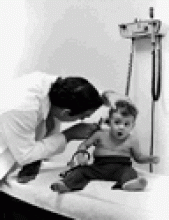Reason for posting: Rosuvastatin (Crestor) is a relatively new cholesterol-lowering drug that has become one of the top-selling new pharmaceuticals since it was first marketed in Canada in February 2003. However, Health Canada recently alerted health care professionals of reports of rhabdomyolysis in some patients taking the drug and warned of predisposing risk factors for the condition.1
The drug: Rosuvastatin, like other statins (3-hydroxy-3-methylglutaryl– coenzyme A reductase inhibitors), improves lipid parameters, including low-density lipoprotein (LDL), high-density lipoprotein and triglyceride levels.2 All statins are known to be associated with a spectrum of myopathies ranging from less serious muscle pain and weakness (occurring in about 1%–5% of patients) to more serious myositis with rhabdomyolysis (defined as muscle symptoms, a markedly elevated serum creatinine kinase level, usually more than 10 times the upper limit of normal, with an elevated creatinine kinase level consistent with pigment-induced nephropathy).3 The rate of statin-induced rhabdomyolysis is low and varies according to the drug used; however, the condition is potentially fatal, resulting in death in about 1 per 6.6 million prescriptions.4
Although the exact mechanism of statin-induced myopathy is unknown, individual genetic susceptibilities and cytochrome P450 interactions are felt to play a part.3 Medications that may increase the risk of statin-associated myopathy include fibrates, niacin, cyclosporine, azole antifungal agents, macrolide antibiotics, HIV protease inhibitors, the calcium-channel blockers verapamil and diltiazem, and the potassium-channel blocker amiodarone.3 Other risk factors for statin-induced myopathy include consumption of grapefruit juice (more than 1 L per day),3 renal impairment, hypothyroidism, a personal or family history of hereditary muscle disorders, previous myotoxicity with other statins or fibrates, a history of alcoholism and being of Chinese or Japanese descent.1
In clinical trials of rosuvastatin, about 3 in 10 000 patients acquired severe myopathy.2 In Canada, 8 cases of rhabdomyolysis associated with the drug have been reported to date: in 2 cases the patients were taking 10 mg of rosuvastatin per day, and in 5 the dose was 40 mg per day; in 1 case the dose was not specified.
What to do: Lifestyle modification (dietary change, exercise and weight loss) is the cornerstone of management for hyperlipidemia and may be all that many patients require to achieve their target lipid levels. As with all statins, patients should be started on the lowest available dose. For rosuvastatin, the dose should be started at 10 mg once daily and gradually titrated upward, with appropriate monitoring of symptoms and creatinine kinase levels, to the lowest effective dose. Minor muscle complaints without elevated creatinine kinase levels may not necessitate discontinuation of the drug. However, patients, particularly those with risk factors for statin-induced myopathy, should be warned of the potential for rhabdomyolysis and told to report immediately any muscle pain, muscle weakness or cramps, or dark urine. If rhabdomyolysis is suspected, the drug should be stopped immediately, and appropriate medical management should be instituted as well as a work-up of predisposing risk factors. For patients found to have statin-induced rhabdomyolysis, consideration should be given to switching to an alternate LDL-lowering drug such as ezetimibe, a recently approved inhibitor of intestinal cholesterol absorption.
Eric Wooltorton CMAJ











